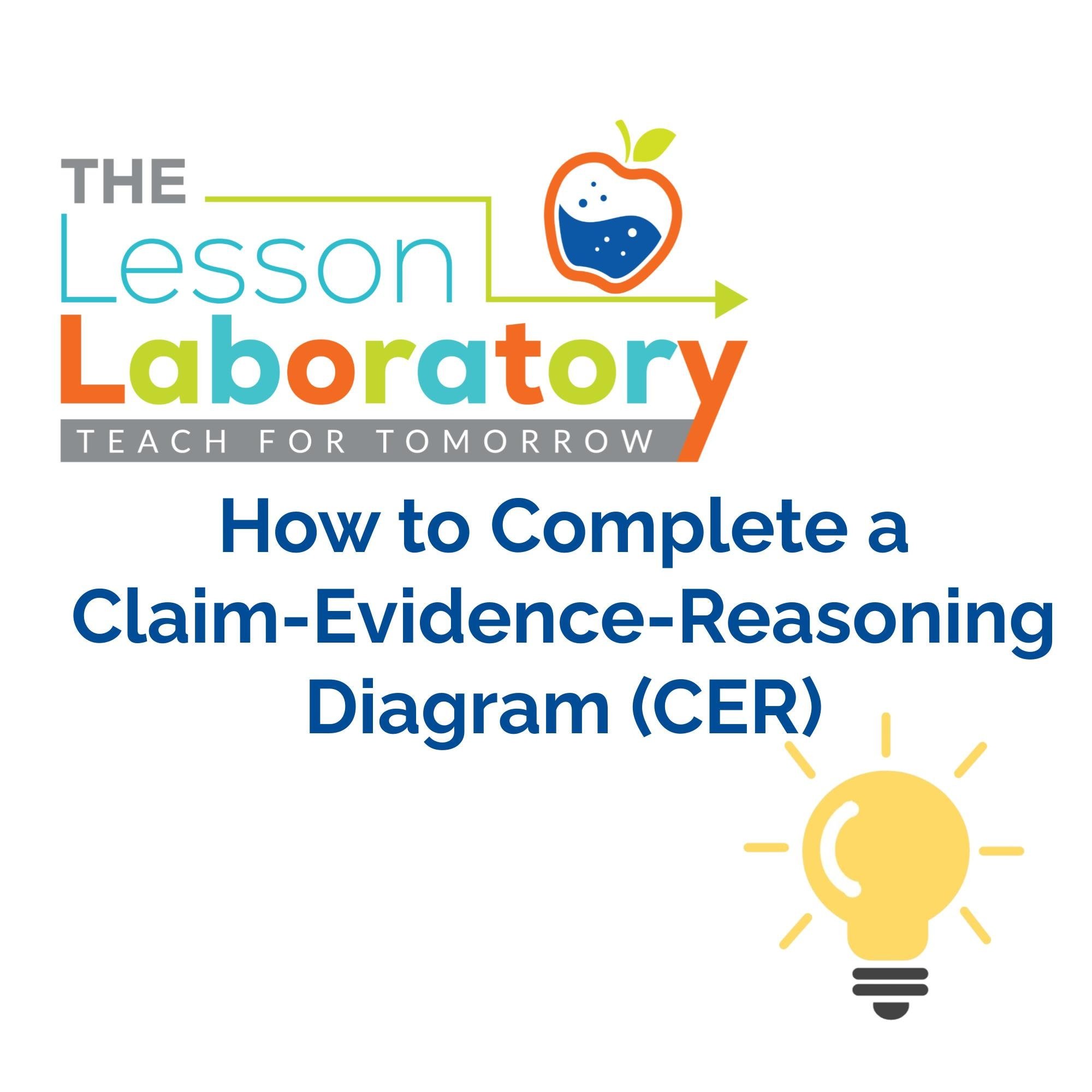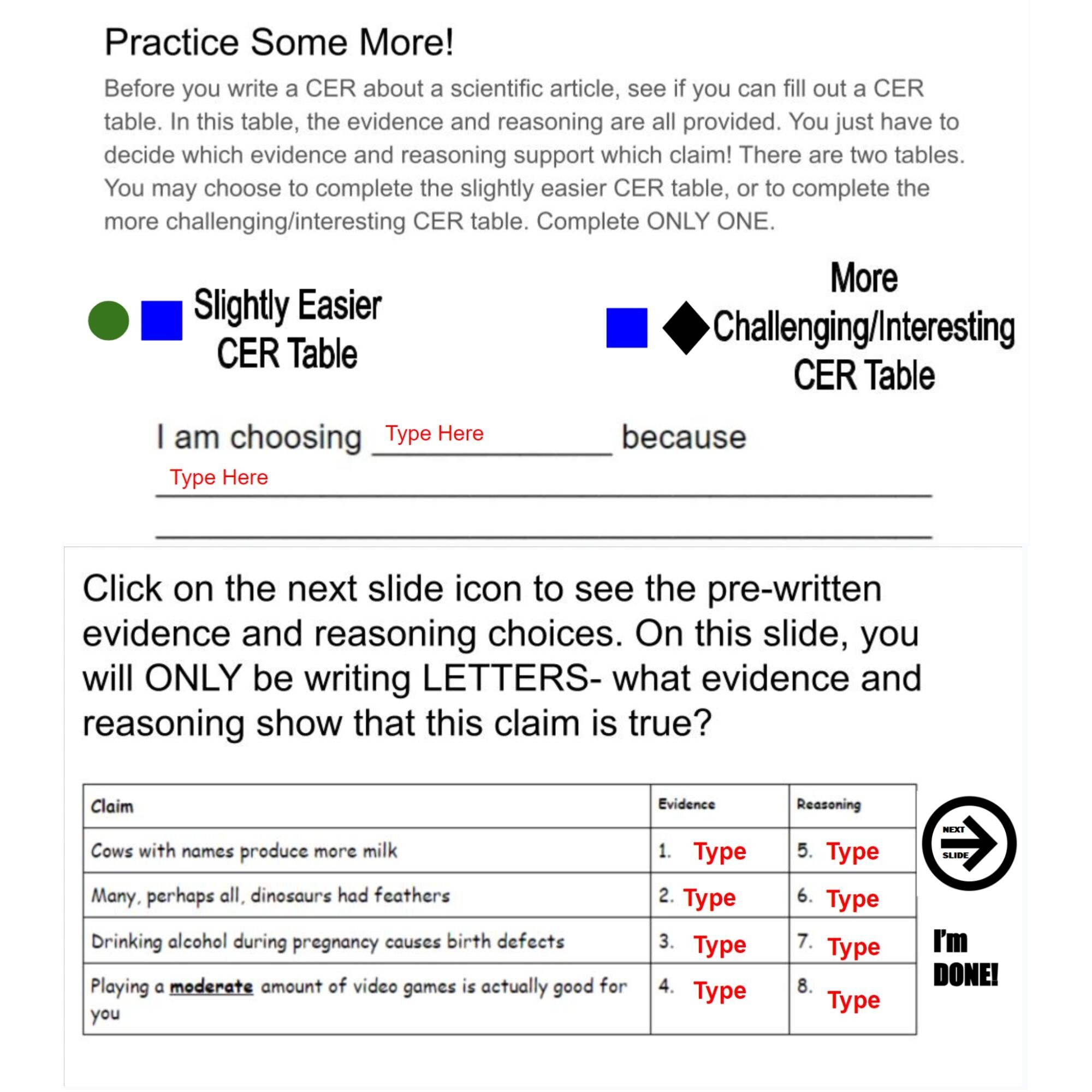 Image 1 of 4
Image 1 of 4

 Image 2 of 4
Image 2 of 4

 Image 3 of 4
Image 3 of 4

 Image 4 of 4
Image 4 of 4





How to Complete a Claim-Evidence-Reasoning Diagram (CER)
Empower Your Students to Master the Art of Claim-Evidence-Reasoning (CER) with This Dynamic Google Slides Lesson!
Cultivate CER Proficiency: This engaging lesson is meticulously designed to equip students with the essential skills to excel in constructing compelling Claim-Evidence-Reasoning diagrams (CER). Through interactive activities and student-choice differentiation, learners will embark on a journey towards CER mastery.
Interactive Classroom Space: The lesson begins in a digital classroom space equipped with a variety of clickable tools that facilitate reading tasks. Students can leverage resources like Google Translate, Rewordify for simplified vocabulary, Natural Readers for text-to-speech functionality, reading skill enhancement articles, and a science dictionary. These tools empower learners to overcome reading challenges and enhance comprehension.
Navigating CER Fundamentals: Students delve into the fundamentals of CER, gaining a comprehensive understanding of the distinctions between claims, evidence, and reasoning—a crucial step towards constructing sound scientific arguments.
Hands-On Practice: The lesson offers a progression of hands-on practice opportunities. Students start by honing their CER skills with simple exercises, gradually advancing to more complex tasks. They cultivate reasoning proficiency by analyzing whimsical yet authentic scientific experiments.
Select Your Challenge: This lesson embraces student choice and differentiation. Learners have the freedom to select articles based on their preferred difficulty level—easy, medium, or challenging. This encourages independent decision-making and caters to diverse learning needs. Little do the students know- you have used your hidden power behind the scenes to steer students towards the difficulty choice that is best for them!
Comprehensive CER Development: Students complete a CER table, carefully matching evidence and reasoning to claims. They have the option to choose between a simpler or more challenging version, both leading to the same essential learning outcomes.
Article Analysis: To cap off their CER journey, students read their selected article, compose a concise 100-word summary, and construct a robust CER diagram. This multifaceted approach ensures a thorough grasp of CER concepts and their practical application.
✨ Vocabulary Enrichment: Learners expand their scientific lexicon by identifying and defining five vocabulary words from their chosen article, enhancing both comprehension and language skills.
Elevate Scientific Argumentation: Download this comprehensive CER lesson now and witness your students soar as adept scientific communicators, equipped to craft compelling arguments based on claims, evidence, and reasoning.
To preview this product, highlight the link below and paste the address into your web browser.
https://docs.google.com/presentation/d/17tKxZ8dj7LzHHwCTbVCxCGTL6R1ZkeqMcETFjzGVBRc/edit?usp=sharing
Grade & Course Recommendation:
Middle School: Grades 6–8, as a scaffold for scientific writing and reasoning.
High School: Grades 9–10, as an ongoing framework for argument writing in science.
Cross-Curricular Connections:
ELA Integration: Reinforces thesis–support–conclusion writing structure.
Social Studies Integration: Supports argumentation in historical and current events.
STEM Integration: Useful across science disciplines for lab report writing.
Daily slide + literacy - based exit ticket included with purchase
Join the Lesson Laboratory and Teach for Tomorrow!
NGSS (Next Generation Science Standards)
Cross-Disciplinary NGSS Alignment
Rather than aligning to one specific content area, this lesson supports Science and Engineering Practices that apply across all NGSS domains.
NGSS Science & Engineering Practices (SEPs):
Engaging in Argument from Evidence: Students practice constructing and defending scientific claims using relevant data.
Constructing Explanations and Designing Solutions: Students organize reasoning that connects evidence to scientific principles.
Obtaining, Evaluating, and Communicating Information: Students read scientific articles and summarize findings in their CER charts.
Applicable NGSS Performance Expectations (for skill integration):
MS-LS1-3 / HS-LS1-3: Explain how feedback mechanisms maintain stability in living systems. (students might apply CER writing to biological examples)
MS-LS4-2 / HS-LS4-1: Use evidence from fossils, anatomy, or genetics to support the theory of evolution.
MS-ETS1-2 / HS-ETS1-2: Evaluate competing explanations or design solutions using evidence-based reasoning.
Crosscutting Concepts:
Cause and effect
Patterns
Systems and system models
Common Core Standards
Grades 7–12:
CCSS.ELA-LITERACY.RST.6-8.1 / RST.9-10.1 / RST.11-12.1: Cite specific textual evidence to support analysis of science and technical texts. (students pull key evidence directly from scientific articles)
CCSS.ELA-LITERACY.RST.6-8.7 / RST.9-10.7 / RST.11-12.7: Integrate quantitative or technical information expressed in words with data, charts, or visual information. (students use diagrams to link evidence to reasoning)
CCSS.ELA-LITERACY.WHST.6-8.1 / WHST.9-10.1 / WHST.11-12.1: Write arguments focused on discipline-specific content using claims and supporting evidence.
CCSS.ELA-LITERACY.WHST.6-8.2 / WHST.9-10.2 / WHST.11-12.2: Write informative/explanatory texts to convey scientific information clearly.
CCSS.ELA-LITERACY.WHST.6-8.9/WHST.9-10.9 / WHST.11-12.9: Draw evidence from informational texts to support analysis and reflection.
Empower Your Students to Master the Art of Claim-Evidence-Reasoning (CER) with This Dynamic Google Slides Lesson!
Cultivate CER Proficiency: This engaging lesson is meticulously designed to equip students with the essential skills to excel in constructing compelling Claim-Evidence-Reasoning diagrams (CER). Through interactive activities and student-choice differentiation, learners will embark on a journey towards CER mastery.
Interactive Classroom Space: The lesson begins in a digital classroom space equipped with a variety of clickable tools that facilitate reading tasks. Students can leverage resources like Google Translate, Rewordify for simplified vocabulary, Natural Readers for text-to-speech functionality, reading skill enhancement articles, and a science dictionary. These tools empower learners to overcome reading challenges and enhance comprehension.
Navigating CER Fundamentals: Students delve into the fundamentals of CER, gaining a comprehensive understanding of the distinctions between claims, evidence, and reasoning—a crucial step towards constructing sound scientific arguments.
Hands-On Practice: The lesson offers a progression of hands-on practice opportunities. Students start by honing their CER skills with simple exercises, gradually advancing to more complex tasks. They cultivate reasoning proficiency by analyzing whimsical yet authentic scientific experiments.
Select Your Challenge: This lesson embraces student choice and differentiation. Learners have the freedom to select articles based on their preferred difficulty level—easy, medium, or challenging. This encourages independent decision-making and caters to diverse learning needs. Little do the students know- you have used your hidden power behind the scenes to steer students towards the difficulty choice that is best for them!
Comprehensive CER Development: Students complete a CER table, carefully matching evidence and reasoning to claims. They have the option to choose between a simpler or more challenging version, both leading to the same essential learning outcomes.
Article Analysis: To cap off their CER journey, students read their selected article, compose a concise 100-word summary, and construct a robust CER diagram. This multifaceted approach ensures a thorough grasp of CER concepts and their practical application.
✨ Vocabulary Enrichment: Learners expand their scientific lexicon by identifying and defining five vocabulary words from their chosen article, enhancing both comprehension and language skills.
Elevate Scientific Argumentation: Download this comprehensive CER lesson now and witness your students soar as adept scientific communicators, equipped to craft compelling arguments based on claims, evidence, and reasoning.
To preview this product, highlight the link below and paste the address into your web browser.
https://docs.google.com/presentation/d/17tKxZ8dj7LzHHwCTbVCxCGTL6R1ZkeqMcETFjzGVBRc/edit?usp=sharing
Grade & Course Recommendation:
Middle School: Grades 6–8, as a scaffold for scientific writing and reasoning.
High School: Grades 9–10, as an ongoing framework for argument writing in science.
Cross-Curricular Connections:
ELA Integration: Reinforces thesis–support–conclusion writing structure.
Social Studies Integration: Supports argumentation in historical and current events.
STEM Integration: Useful across science disciplines for lab report writing.
Daily slide + literacy - based exit ticket included with purchase
Join the Lesson Laboratory and Teach for Tomorrow!
NGSS (Next Generation Science Standards)
Cross-Disciplinary NGSS Alignment
Rather than aligning to one specific content area, this lesson supports Science and Engineering Practices that apply across all NGSS domains.
NGSS Science & Engineering Practices (SEPs):
Engaging in Argument from Evidence: Students practice constructing and defending scientific claims using relevant data.
Constructing Explanations and Designing Solutions: Students organize reasoning that connects evidence to scientific principles.
Obtaining, Evaluating, and Communicating Information: Students read scientific articles and summarize findings in their CER charts.
Applicable NGSS Performance Expectations (for skill integration):
MS-LS1-3 / HS-LS1-3: Explain how feedback mechanisms maintain stability in living systems. (students might apply CER writing to biological examples)
MS-LS4-2 / HS-LS4-1: Use evidence from fossils, anatomy, or genetics to support the theory of evolution.
MS-ETS1-2 / HS-ETS1-2: Evaluate competing explanations or design solutions using evidence-based reasoning.
Crosscutting Concepts:
Cause and effect
Patterns
Systems and system models
Common Core Standards
Grades 7–12:
CCSS.ELA-LITERACY.RST.6-8.1 / RST.9-10.1 / RST.11-12.1: Cite specific textual evidence to support analysis of science and technical texts. (students pull key evidence directly from scientific articles)
CCSS.ELA-LITERACY.RST.6-8.7 / RST.9-10.7 / RST.11-12.7: Integrate quantitative or technical information expressed in words with data, charts, or visual information. (students use diagrams to link evidence to reasoning)
CCSS.ELA-LITERACY.WHST.6-8.1 / WHST.9-10.1 / WHST.11-12.1: Write arguments focused on discipline-specific content using claims and supporting evidence.
CCSS.ELA-LITERACY.WHST.6-8.2 / WHST.9-10.2 / WHST.11-12.2: Write informative/explanatory texts to convey scientific information clearly.
CCSS.ELA-LITERACY.WHST.6-8.9/WHST.9-10.9 / WHST.11-12.9: Draw evidence from informational texts to support analysis and reflection.